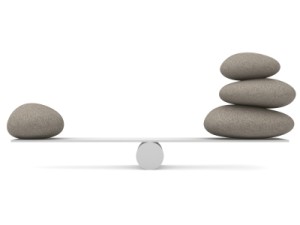 You have to admire fools. They really work at it much harder than their more sensible counterparts.
You have to admire fools. They really work at it much harder than their more sensible counterparts.
“Any fool can make something complicated. It takes a genius to make it simple.” – Woody Guthrie
I probably fall into the fool category myself, sometimes. I’m pretty good at complicating my life by creating layered intricacies and bends in what should have been a straight path. At other times I actually amaze myself by reaching for a pencil instead of booting up my iPad or computer.
I’m not sure if it’s the piled up years or experiences that have lead me to appreciate simple solutions, but I’ll tell ya, when it comes to technology and wheelchair users, simple is as brilliant as it gets.
Many wheelchair users don’t realize how complicated technology can make their world until they give it some thought. The technology dominoes just keep stacking up and never seem to line up or fall right. Some of the time the technology isn’t working right. Some of the time the technology doesn’t mesh well with other technologies in use or is a bad personal or lifestyle fit. At other times the technology is overkill and most functions never get used or maintaining and using it takes more time than it’s worth. It can easily get in the way or cause frustration.
For many wheelchair users technology is an important part of daily life. There’s the wheelchair and any other technologies that are added to it or interface with it or the user. There’s lots of it around- Communication devices, advanced controls, seating components, respiratory equipment, safety equipment, transfer devices, gadgets, gizmos, and toys that we could go on listing for quite some time.
Where’s this going? It’s not a technology bash for sure. Assistive technology is the saving grace for many a person with a disability. It has also been the cause of much frustration and disappointment. It’s actually all about balancing the fool with the genius and getting the most out of assistive technology. In order to do so there must be a purpose to the technology. It must fill a void and not just fill up space.
When it comes to assistive technology think simple. Balance your technology and gear it firstly to resolve the functional issues that need resolving. The must do things or the “purpose”. Start by deciding on what you really need in the way of technology, be it a wheelchair or an assistive device, and what you may “want”. “Want” is great and it is appreciated by Santa Clause (only if you’re good) and by marketers (only if you have money) but “need” is much more important to you.
Thinking “Need” accomplishes many things. It simplifies your life by eliminating technological fluff that only gets in the way, goes unused, clutters up your garage, and costs a bunch of extra bucks. It minimizes frustration and minimizes workload and time spent on learning and maintaining devices that you won’t use. It minimizes your technological arsenal so you’ll spend less money on devices, repairs, upgrades and maintenance.
How many times have you “wanted” something and once obtained have never really used it? How many times have you not used something you really needed? The balance is in having the smallest array of the simplest technologies that fill your needs. Welcome home genius!
An FYI- It is estimated that up to 70% of all assistive technology devices ultimately go unused. Some of the reasons:
- Not reliable (junk)
- Difficult to use or learn (intellectually or physically challenging)
- Doesn’t work or interface well with other assistive devices (incompatible)
- Expensive to maintain (costly)
- Time consuming to use or maintain (time consuming)
- Resolves certain problems but creates new ones (perpetually challenging)
- Doesn’t resolve an existing problem or fill a need (useless)
Those are what closets, garages, and Craigs List are made of.
Ziggi Landsman
Director of Assistive Technology
United Spinal Association
